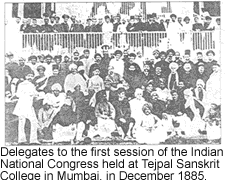
Dimdima
Online Children's Magazine from India

Dimdima
Online Children's Magazine from India
| The Battle Lines are Drawn |
|
Early political organizations in the country were modelled on those in
England. One of the first things the Banga-bhasha Prakashika Sabha founded in
1836 discussed at its very first meeting, was the seating arrangements. A
member pointed out that at meetings Englishmen sat on chairs with a table in
the centre, and each member rose from his seat when addressing the gathering.
The member proposed and all others agreed, that the same procedure should be
followed in their meetings too. |
Towards the end of the 19th century, the political organizations most active were the British Indian Association in Calcutta, the Bombay Presidency Association, Sarvajanik Sabha in Pune and Mahajan Sabha in Madras. Though these organisations were in touch with each other, they lacked the ability to work jointly for the national or public good.
Ganesh Vasudev Joshi of Sarvajanik Sabha, Pune, dreamt of an All-India
organisation. So did Surendranath Banerji who convened the National Conference in Calcutta in 1883. In Madras, a group of eminent public figures including Annie Besant and Raghunatha Rao initiated a move to establish an All-India organization. All these leaders readily responded when  A.O. Hume convened the Indian National Congress to meet in Mumbai in the last week of December 1885.
A.O. Hume convened the Indian National Congress to meet in Mumbai in the last week of December 1885.
The Congress, which elected Womesh Chandra Bannerjee as its president and A.O. Hume as the secretary, caught the imagination of the people. Other political organisations of the day either merged with the Congress or participated in its programmes even while retaining their regional identity.
The INC aimed to promote fellow-feeling and friendship between people working
for the common good all over the country and to nurture and develop feelings of
national unity.
Though Englishmen like A.O. Hume were associated with the founding of the
Congress, the British reaction was definitely hostile. The London Times
described the Congress as a party of lawyers, school masters and newspaper
editors. "That they can talk and that they can write, we are in no doubt at all," wrote the leading daily from London in one of its editorials. "But that they can govern wisely, or that they can enforce submission to their rule, wise or unwise, we are not equally sure." The editorial concluded with a warning to the newly formed Congress: "…It was by force that India was won, and it is by
force that India must be governed....If we were to withdraw, it would be in
favour not of the most fluent tongue or of the strongest arm but the sharpest
sword."
The battle lines were being drawn!
Dimdima is the Sanskrit word for ‘drumbeat’. In olden days, victory in battle was heralded by the beat of drums or any important news to be conveyed to the people used to be accompanied with drumbeats.
Bharatiya Vidya Bhavan
K. M Munshi Marg,
Chowpatty, Mumbai - 400 007
email : editor@dimdima.com
Bharatiya Vidya Bhavan
505, Sane Guruji Marg,
Tardeo, Mumbai - 400 034
email : promo@dimdima.com
Dimdima.com, the Children's Website of Bharatiya Vidya Bhavan launched in 2000 and came out with a Printed version of Dimdima Magazine in 2004. At present the Printed Version have more than 35,000 subscribers from India and Abroad.